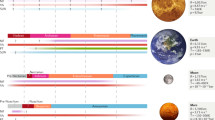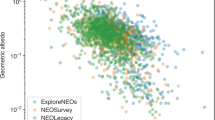Abstract
OUR earth is one of a system of nine planets which, with millions of smaller bodies—asteroids, comets, and meteors circle round the sun; our sun is one of a system of millions of stars which circle about one another; this star-system is one of millions of star-systems—and here, so far as we know, the sequence ends abruptly. These star-systems are the biggest objects known to science; there is nothing beyond them except the great universe itself. They form the largest subdivision of the universe, and it is from this circumstance that they derive their special importance to science.
This is a preview of subscription content, access via your institution
Access options
Subscribe to this journal
Receive 51 print issues and online access
$199.00 per year
only $3.90 per issue
Buy this article
- Purchase on Springer Link
- Instant access to full article PDF
Prices may be subject to local taxes which are calculated during checkout
Similar content being viewed by others
Rights and permissions
About this article
Cite this article
JEANS, J. Beyond the Milky Way*. Nature 128, 825–832 (1931). https://doi.org/10.1038/128825a0
Issue Date:
DOI: https://doi.org/10.1038/128825a0
Comments
By submitting a comment you agree to abide by our Terms and Community Guidelines. If you find something abusive or that does not comply with our terms or guidelines please flag it as inappropriate.



